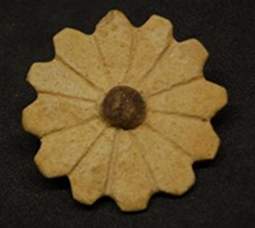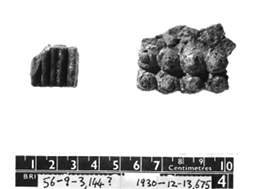Kalhu: from prehistoric settlement to royal capital
The city of Kalhu reached the peak of its glory in the 9th and 8th centuries BC, when it served as Assyria's administrative capital and the residence of the Assyrian king. However, archaeological and textual evidence shows that the settlement's occupation stretches back to much earlier times.
The early settlement at Kawalhum

Image 1: An example of the glazed faience TT rosettes excavated by Max Mallowan PGP 's team to the south of the temple of Kidmuru on Kalhu's citadel TT mound. The rosettes were perhaps originally used to decorate a temple. The black boss TT in the centre of the rosette is the only surviving colour element of this once vibrant object. BM 130870 [http://www.britishmuseum.org/research/collection_online/collection_object_details.aspx?objectId=369409&partId=1]. View large image on British Museum website [http://www.britishmuseum.org/research/collection_online/collection_object_details/collection_image_gallery.aspx?assetId=1145645&objectId=369409&partId=1]. © The Trustees of the British Museum.
The city of Kalhu (modern Nimrud) is located along the northeast bank of the Tigris PGP river, near its confluence with the Greater Zab PGP , some 35 kilometres downstream of Nineveh PGP (modern Mosul PGP ) in the heartland of ancient Assyria [http://oracc.org/saao/aebp/essentials/countries/centralassyria]. The settlement's location had many important benefits. An irrigation canal brought water from the Greater Zab to the city, and enabled the locals to make the most of the region's fertile soil to grow various crops. The two rivers provided transport for people, troops and goods. Kalhu's central location meant that the other major Assyrian centres - Nineveh, Assur PGP and Arbela PGP - were within relatively easy reach. A natural source of bitumen TT , a substance used for waterproofing pavements and other structures, was also located conveniently close to the city. Overall, Kalhu's position enabled it to play an important role in overland and riverine trade networks both within Assyria and further afield.
Very little is known about the earliest settlement at Kalhu because the deepest layers of the site have never been formally excavated. However, work at Nimrud during the 19th and 20th centuries has uncovered evidence of occupation which long predates the city's heyday in the 9th century BC, when king Assurnasirpal II (r. 883-859 BC) transformed the city into his magnificent royal capital. During excavations in the southeast corner of the citadel TT mound, Max Mallowan PGP found potsherds TT and flints dating back to an archaeological layer TT known as Nineveh V - evidence that the site was occupied already by the 3rd millennium BC. A grave uncovered underneath the temple of Nabu was dated by Mallowan to around 1750 BC. Unfortunately these isolated finds don't allow any meaningful reconstruction of the settlement, and since no contemporary textual sources have been found, Kalhu's role in this early period remains something of a mystery.
Kalhu in the Middle-Assyrian period

Image 2: This inauspicious-looking object is a spacer bead made of translucent blue glass using an open mould. It was found underneath the Burnt Palace in Kalhu, in a tomb which probably dates from the Middle Assyrian TT period (c.1400-c.1050 BC). BM 1856,0903.144. View large image on British Museum website. © The Trustees of the British Museum.
We are on slightly firmer ground with the Middle Assyrian period (c.1400-1050 BC). A seal TT impression TT and a number of glazed TT faience TT ornaments (Image 1) from this period were uncovered near the temple of Kidmuru. This temple is thought to have a long history and is certainly the only temple known to predate Assurnasirpal II's rebuilding of the city. Tentative evidence that the settlement enjoyed some importance at this time comes from a letter found at Assur PGP and dated to c.1200 BC, according to which Kassite prisoners of war were housed in the city. Later on, written sources from the reign of Tiglath-pileser I PGP (r. 1114-1076 BC) mention Kalhu as a provincial capital, a status which the city may have enjoyed already under earlier kings and would continue to enjoy until the final days of the Assyrian empire. This suggests that we should probably not take at face value Assurnasirpal's claim that "the ancient city of Kalhu, which Shalmaneser (I)... had built - this city had become dilapidated; it lay dormant" (1).
It was the reign of Assurnasirpal II that brought about a turning point in Kalhu's fortunes. The king's successful military expeditions provided him with great wealth and resources which he used to completely rebuild Kalhu. The city underwent a dramatic transformation from an unremarkable provincial town to an opulent capital city which served as the seat of royal power for the next 170 years and was a fitting symbol of Assyria's imperial power.
Content last modified: 18 Dec 2019
References
- Grayson, A.K., 1991. Assyrian Rulers of the Early First Millennium BC: I (1114-859 BC) (Royal Inscriptions of Mesopotamia. Assyrian Periods. Volume 2), Toronto: University of Toronto Press, pp. 285, A.0.101.28:v 1-2. (Find in text ^)
Further reading
- Oates, D. and J. Oates, 2001. Nimrud, An Assyrian Imperial City Revealed, London: British School of Archaeology in Iraq ( free PDF from BISI, 128 MB).
- Postgate, J.N. and J.E. Reade, 1976-1980. "Kalhu", Reallexikon der Assyriologie und Vorderasiatischen Archäologie 5, Berlin: Walter de Gruyter, pp. 303-323.
- Reade, J.E., 1982. "Nimrud", in J.E. Curtis (ed.), Fifty Years of Mesopotamian Discovery: The Work of the British School of Archaeology in Iraq, 1932-1982, London: British School of Archaeology in Iraq, pp. 99-112 (free PDF from BISI, 131 MB).
Silvie Zamazalová
Silvie Zamazalová, 'Kalhu: from prehistoric settlement to royal capital', Nimrud: Materialities of Assyrian Knowledge Production, The Nimrud Project at Oracc.org, 2019 [http://oracc.museum.upenn.edu/nimrud/ancientkalhu/thecity/earlykalhu/]